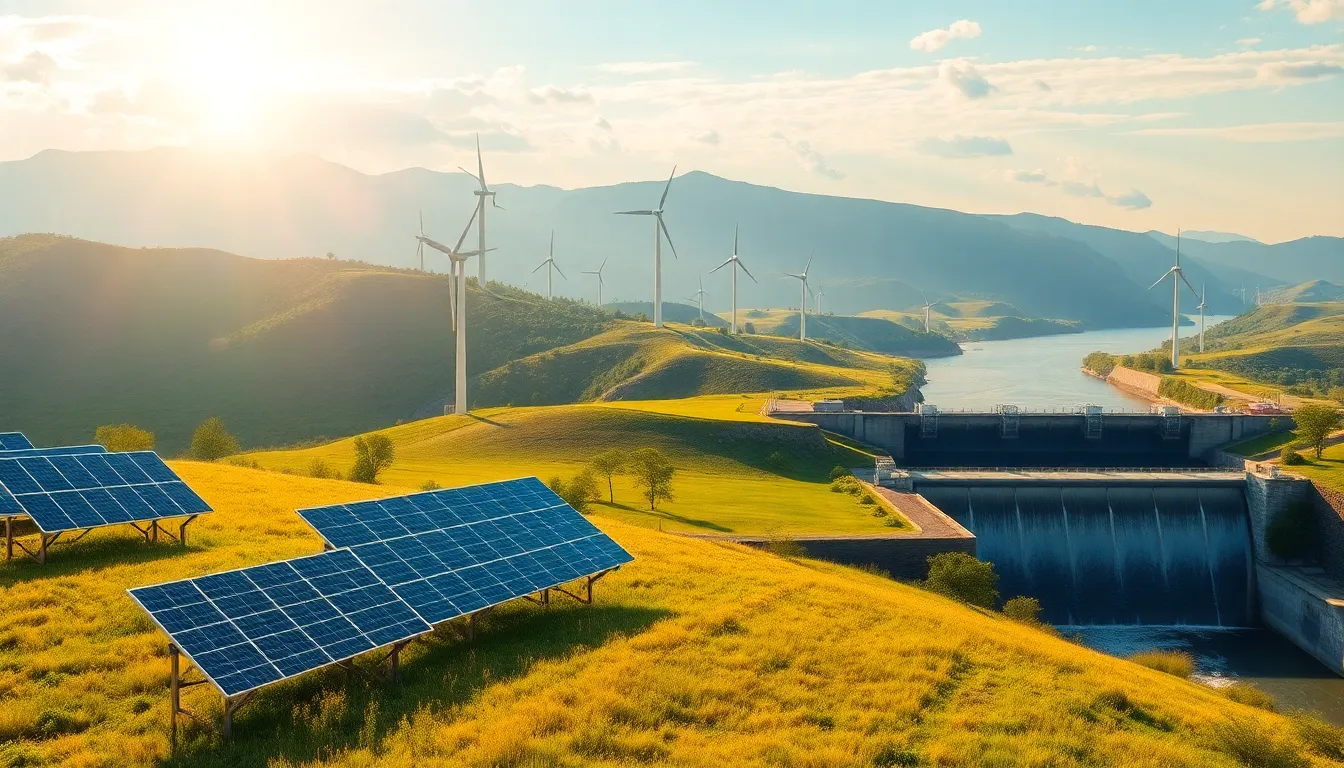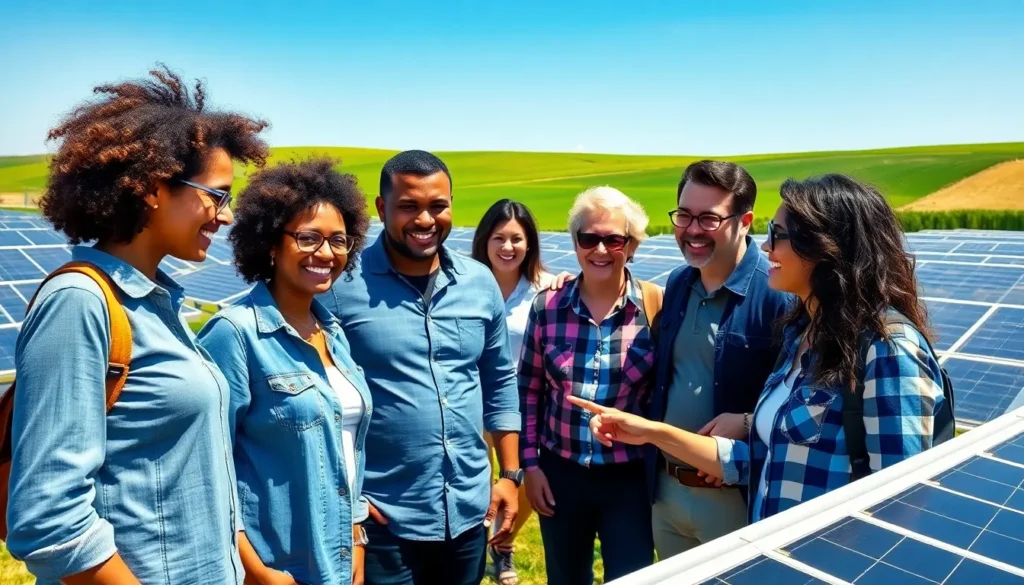Table of Contents
ToggleAs the world grapples with the pressing challenges of climate change and dwindling fossil fuel reserves, alternative energy has emerged as a beacon of hope. This innovative sector encompasses a variety of renewable sources, including solar, wind, hydro, and geothermal energy, each offering unique benefits that promise to reshape the global energy landscape.
Transitioning to alternative energy isn’t just an environmental imperative; it’s also an economic opportunity. With advancements in technology and increasing investment, these sustainable solutions are becoming more accessible and affordable. As society moves toward a greener future, understanding the potential of alternative energy sources is crucial for individuals, businesses, and governments alike.
Overview Of Alternative Energy
Alternative energy encompasses various energy sources that combat climate change and reduce dependence on fossil fuels. These renewable sources include solar, wind, hydro, and geothermal energy, each contributing uniquely to the energy landscape.
Solar Energy
Solar energy harnesses sunlight through photovoltaic cells, converting light into electricity. It offers significant benefits, including low operating costs and the potential for widespread installation on rooftops and vacant land.
Wind Energy
Wind energy utilizes turbines to convert wind’s kinetic energy into electricity. Wind farms located on land or offshore provide substantial energy yield with minimal emissions, making them a viable alternative energy option.
Hydro Energy
Hydro energy generates power by using flowing water to turn turbines. Hydroelectric plants capture energy from rivers and dams, producing reliable electricity, particularly in regions with abundant water resources.
Geothermal Energy
Geothermal energy taps into the Earth’s internal heat to generate electricity and provide direct heating. Regions with volcanic activity or hot springs offer the highest potential for this clean energy source, enabling sustainable heating solutions.
Economic Opportunities
Investing in alternative energy drives innovation and job creation in many sectors. Increased technological advancements lower production costs and improve efficiency, making renewable solutions competitive with traditional fossil fuels.
By embracing alternative energy, society can pave the way to a more sustainable future, ensuring energy security while mitigating environmental hazards.
Types Of Alternative Energy

Various types of alternative energy sources play a crucial role in creating a sustainable energy future. Each type presents unique characteristics and advantages that contribute to reducing reliance on fossil fuels.
Solar Energy
Solar energy harnesses sunlight through photovoltaic cells or solar thermal systems. Photovoltaic cells convert sunlight directly into electricity, while solar thermal systems use sunlight to heat fluids, which then generate steam to drive turbines. Globally, solar energy capacity reached over 1,100 gigawatts in 2021, demonstrating significant growth as costs drop and technology improves.
Wind Energy
Wind energy captures wind’s kinetic energy using turbines to produce electricity. This energy source relies on the availability of consistent wind patterns. As of 2022, the global wind energy capacity exceeded 900 gigawatts, confirming its rapidly growing role in the clean energy landscape. Wind farms can be installed onshore or offshore, maximizing energy output.
Hydropower
Hydropower generates electricity by harnessing the energy from flowing or falling water. Dams typically store water in reservoirs, releasing it through turbines to produce electricity. According to the International Hydropower Association, hydropower accounted for about 16% of global electricity generation in 2020, making it a significant player in renewable energy.
Biomass Energy
Biomass energy derives from organic materials like plant and animal waste. This energy source can be converted into heat or electricity through combustion or biochemical processes. Biomass contributes around 5% of total U.S. energy, illustrating its potential as a renewable resource. Innovations continue to emerge, enhancing efficiency and sustainability in biomass production.
Geothermal Energy
Geothermal energy taps into the Earth’s internal heat for electricity and heating purposes. This energy source utilizes steam or hot water reservoirs found beneath the Earth’s surface. The Geothermal Energy Association reported that the U.S. had approximately 3.8 gigawatts of installed geothermal capacity as of 2020. Geothermal energy offers a reliable source of power with minimal environmental impact.
Benefits Of Alternative Energy
Alternative energy sources offer significant advantages that contribute to a sustainable future. These benefits encompass environmental, economic, and energy independence aspects.
Environmental Impact
Alternative energy sources significantly reduce greenhouse gas emissions compared to fossil fuels. Solar and wind power, for example, produce electricity with minimal environmental degradation. Biomass, when managed sustainably, recycles carbon dioxide rather than adding to atmospheric concentrations. Additionally, hydro and geothermal energy harness natural processes without depleting resources. Transitioning to these renewable sources diminishes air and water pollution, promoting healthier ecosystems.
Economic Advantages
Alternative energy creates job opportunities across various sectors. It’s estimated that over 11 million people work in renewable energy worldwide, a number expected to grow as investments increase. Renewable energy projects, such as solar panel installations and wind farm construction, stimulate local economies. Moreover, room for innovation in energy technologies leads to increased efficiency and lowered costs. As alternative energy becomes more affordable, consumers benefit from reduced energy bills, strengthening financial resilience.
Energy Independence
Alternative energy enhances energy security by diversifying energy sources. Utilizing local renewable resources reduces reliance on imported fuels, mitigating the risks associated with geopolitical tensions and market fluctuations. For example, countries investing in solar or wind energy decrease vulnerability to price volatility in fossil fuel markets. This shift fosters a more stable and resilient energy infrastructure, ensuring consistent energy availability for households and businesses alike.
Challenges Facing Alternative Energy
Despite the benefits, alternative energy faces several significant challenges that hinder its widespread adoption and effectiveness. Addressing these obstacles is crucial for a sustainable energy transition.
Technological Limitations
Technological limitations play a critical role in the current scalability of alternative energy. Solar and wind energy systems require efficient energy storage solutions to address intermittency issues. Battery technologies, such as lithium-ion, face challenges related to capacity, lifespan, and environmental impact. The efficiency of solar panels and wind turbines also varies based on location and weather conditions, limiting their reliability. Advancements in energy storage and the development of smart grid technologies can mitigate these issues but require ongoing research and investment.
Initial Costs
Initial costs for alternative energy installations often pose a barrier to entry. Solar panels and wind turbines require substantial upfront capital investments for purchasing and installing the equipment. Residential and commercial entities may hesitate to transition due to these costs, despite long-term savings on energy bills. Financial incentives, such as tax credits and subsidies, can help offset these initial costs, making alternative energy sources more attractive. As technology advances and production scales up, prices have shown a downward trend, which may encourage further adoption.
Policy and Regulation Issues
Policy and regulation issues significantly affect the growth of alternative energy sectors. Inconsistent government policies, such as changes in subsidies or incentives, create uncertainty for investors and developers. Additionally, regulatory frameworks may not adequately support the integration of alternative energy into existing power grids, complicating deployment. In some regions, fossil fuel interests dominate political landscapes, impeding the advancement of renewable initiatives. Establishing stable, long-term policies can provide a conducive environment for alternative energy development and bolster investment.
The shift toward alternative energy represents a pivotal moment in tackling climate change and ensuring sustainable energy for future generations. By embracing renewable sources like solar, wind, hydro, biomass, and geothermal energy, society can significantly reduce its carbon footprint while unlocking new economic opportunities.
As technology advances and investments grow, alternative energy becomes more viable and competitive against traditional fossil fuels. Addressing challenges such as energy storage and regulatory hurdles will be crucial for widespread adoption.
Ultimately, fostering a robust alternative energy landscape is essential for enhancing energy security and promoting healthier ecosystems. The journey toward a greener future is not just necessary; it’s an opportunity for innovation and growth that can benefit everyone.







